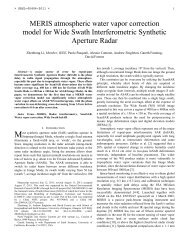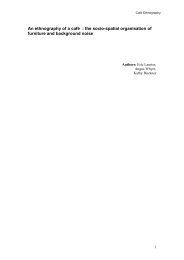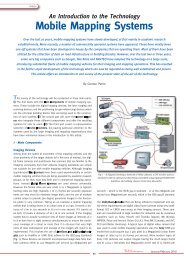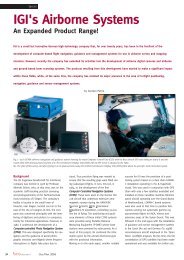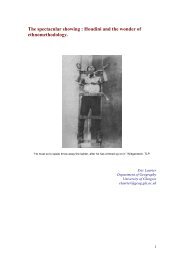presentation (pdf)
presentation (pdf)
presentation (pdf)
You also want an ePaper? Increase the reach of your titles
YUMPU automatically turns print PDFs into web optimized ePapers that Google loves.
Nanoscale characterization of the ‘critical zone’ of<br />
naturally weathered minerals by FIB and TEM<br />
David Brown, Mark Hodson, Maureen MacKenzie,<br />
Roland Hellmann, Caroline Smith & Martin Lee
Outline<br />
• The critical zone: models for feldspar weathering<br />
• Materials<br />
• Focused Ion Beam (FIB) technique<br />
• Results<br />
• Integration with XPS<br />
Aim<br />
• FIB-TEM investigation of mineral weathering:<br />
– Grain surface topography; structure; composition;<br />
reaction products<br />
– How do feldspars weather in natural systems?
Models for feldspar weathering
Models for feldspar weathering
Models are difficult to test:<br />
• Reactive sites at the bottom of etch pits<br />
• Beneath reaction products or organic/inorganic debris.
Advantages of FIB<br />
• Previous techniques for TEM foil preparation destructive:<br />
– (e.g. microtome, Ar ion milling)<br />
• FIB allows site specific cross sectional slices to be<br />
prepared, through the critical zone<br />
• Direct observation of layers?
Materials<br />
• Naturally weathered alkali feldspars from post-glacial<br />
soils<br />
• Shap (north-west England)<br />
– Acidic (pH 3.4) & waterlogged peat.<br />
Grain surfaces free of weathering<br />
products.<br />
• Glen Feshie (Cairngorm, Scotland)<br />
– Soil chronosequence (80 yr-1 kyr).<br />
Grain surfaces have abundant<br />
weathering products.
FIB Technique
Beam Damage<br />
• Sample can be damaged by<br />
the beam<br />
– 1 µm Pt strip<br />
• Au coating essential<br />
– Amorphisation of the<br />
sample<br />
• >85 nm of Au required<br />
• Supported by SRIM<br />
modelling (
Amorphous layers?<br />
• No amorphous layers recognised on pH1 laboratory<br />
dissolution experiments and on naturally weathered<br />
samples<br />
• Previous experiments – 10’s of nm, where are the layers?
• Can Au coating<br />
(by sputtering)<br />
damage sample?<br />
• Grains partially<br />
covered by resin<br />
• No amorphous<br />
material<br />
• Evaporated Au<br />
• No amorphous<br />
material<br />
Sputtering Damage?<br />
Pt<br />
Au<br />
Resin<br />
Au<br />
Crystalline<br />
feldspar<br />
Pt
How are the feldspars<br />
weathering?
Shap alkali feldspars: microtopography<br />
(001)<br />
Coherent<br />
albite<br />
lamellae<br />
• Free of reaction products, but pitted<br />
• Corrugations at sites of coherent albite lamellae
Shap alkali feldspars: microtopography<br />
• Albite dissolves more rapidly<br />
– Composition or magnitude of elastic coherency strain<br />
– Higher strain on albite; dissolves faster
Shap alkali feldspars: etch pit networks<br />
• Pits extend into grain interiors;<br />
• “Etch tubes” - fluids exploit nanotunnels (Fitz Gerald et al. 2006)
Shap alkali feldspars: microstructure of pit walls<br />
• Pits extend along former albite lamellae into the grain interior
Shap alkali feldspars: microstructure of pit walls<br />
• Pit walls crystalline throughout; no amorphous layers
Glen Feshie<br />
• Microbes, reaction products<br />
• Pits dug in river terraces
Glen Feshie feldspars: weathering products<br />
• Some amorphous weathering products; others 1.0 nm<br />
Fe-aluminosilicate clays
Glen Feshie (80 yr): clay-feldspar interface<br />
• Poorly crystalline material occurs between clays and<br />
grain surface; little evidence for feldspar recrystallization:
Glen Feshie (1.1 kyr): reconstruction at grain surfaces<br />
• Reaction products may have a gradational interface with<br />
feldspar, possible interaction?
Glen Feshie (1.1 kyr): crystallization of clays<br />
• Reaction products have crystallised K-aluminosilicates (illite)
Conclusions<br />
• Shap weathers by stoichiometric<br />
dissolution<br />
– Centred on reactive sites<br />
controlled by composition and/or<br />
strain<br />
– Leached layers must be < ~2 nm<br />
• Glen Feshie weathering products<br />
grow passively on grains from bulk<br />
waters<br />
– Some amorphous<br />
– Crystallises to form clays
XPS on Shap feldspars<br />
• 15°, 45°and 90°= 2.5, 6 and 9 nm<br />
• Si enriched, K and Na depleted<br />
~1-2 nm<br />
• Surface chemistry modified<br />
without destroying feldspar<br />
framework (leaching of alkalis)<br />
• Layer is present (1-2 nm) but<br />
difficult to resolve on TEM.<br />
XPS data represents “dilution<br />
of result” with depth
TEM layers: a cautionary tale<br />
• Previous TEM layers (tens of nm thick):<br />
– Probable beam damage!<br />
Amorphous<br />
Au & Pt Au & Pt<br />
50 nm 50 nm



